Jan Svoboda. Magnetic Techniques for the Treatment of Materials
Подождите немного. Документ загружается.

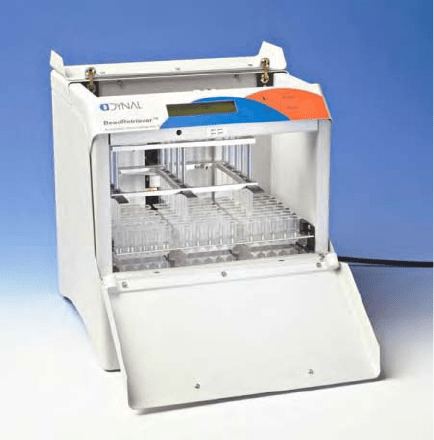
530 CHAPTER 6. INDUSTRIAL APPLICATIONS
Figure 6.53: Bench-top BeadRetriever
WP
instrument which performs auto-
mated immunomagnetic separation using Dynabeads
R
°
magnetic
carriers (courtesy Dynal Biotech ASA).
6.5.3 The application of magnetic separation
Cell separation and isolation of nucleic acids
The isolation and removal of cells can be achieved using magnetic carriers as
has been described above. The principle of separation is based on the fact
that practically all body cells bear a specific cluster of dierentiation (CD)
receptors on their surface. These receptors determine specific functions of the
cells in the body. By coating the magnetic particles with antibodies against
respective CD receptors all types of cells can in principle be isolated from the
corresponding body fluids or cell cultures. The magnetic carrier technology
thus opens particularly interesting perspectives for the therapy and diagnosis
of tumours. The quantitative isolation and determination of tumour cells from
tissue samples can provide information on the progress of therapy. Magnetic
carriers can also play a role in the separation of tumour cells during bone marrow
transplants [M41].
The magnetic a!nity separation is used particularly in molecular biology
for isolation of nucleic acids (both RNA and DNA). The separated nucleic acids
can be eluted from the beads and used for further applications [S88].
6.5. MAGNETIC CARRIERS AND SEPARATION IN BIOSCIENCES 531
Immunomagnetic separation Immunomagnetic separation is the technique
that uses antibodies immobilized on magnetic carriers, for capturing target cells.
Immunomagnetic particles specific for a target organism are usually suspended
in an aliquot of the mixed cell suspension. After an appropriate incubation pe-
riod the immunomagnetic particles with bound target cells are separated from
the suspension in a magnetic separator. The remaining suspension is removed
and the magnetic particles are washed with a suitable solution. An important
advantage of immunomagnetic separation is the ability to capture and detect
dead or severely damaged microorganisms, which cannot be detected by stan-
dard cultivation processes [S89, Y10].
Immunomagnetic separation is often used in microbiology, cell biology and
parasitology. Magnetic particles are used for the isolation of various cell sub-
sets according to their CD receptors directly e.g. from tissue homogenates.
Immunomagnetic removal of cancer cells from the blood and bone marrow of
patients suering from cancer is being practiced in numerous laboratories [S88].
A bench-top BeadRetriever
WP
instrument that performs automated immuno-
magnetic separation is shown in Fig. 6.53.
Drug and radionuclide targeting
Although selective delivery of drugs to specific targets within an organism would
be beneficial to many patients, conventional treatment is not able to achieve sig-
nificant drug concentration in a target without distributing the drug throughout
most other, usually healthy body parts and without developing drug resistance.
To circumvent these pitfalls, magnetic microspheres or nanospheres have
been used for immobilization or encapsulation of drugs or radionuclides. These
magnetic particles are then transported to a target position using an external
magnetic field. Localized delivery of drugs at high concentration, for instance
to tumours, a significant reduction of the toxic eects of most conventional
anticancer drugs to healthy tissue has been achieved [P22, L26, J8, A43].
Transport of magnetic particles loaded with drugs can be achieved by mag-
netically guiding the particles using a high-gradient magnetic field. As a result
of a short reach of such a magnetic field it is rather di!cult to achieve su!cient
focus and drug accumulation in a tissue that is located deep inside a body. A
dierent principle of localizing a drug into the tumour area is illustrated in Fig.
6.54. A suspension of magnetic particles can be injected through a catheter
into the artery feeding the tumour while a magnetic field is imposed onto the
tumour area. The magnetic field can be conveniently generated by permanent
magnets located outside the patient’s body close to the tumour [K34].
Tumour regression through selective magnetic delivery of cytotoxic agents
to the tumour site has been observed in numerous clinical cases, such as brain
tumour and kidney and colon carcinoma. In order to increase the rate of drug
delivery, the size of magnetic carriers should be as large as possible, compatible
with the fact that the smallest blood vessels have a 5 m inner diameter. Iron
oxide particles are well tolerated and magnetite-based agents are approved for
human use.

532 CHAPTER 6. INDUSTRIAL APPLICATIONS
S
N
S
N
Magnet
Catheter
Artery
Tumour
Figure 6.54: Schematic diagram of the introduction of drug-loaded magnetic
carriers into a tumour (adapted from [K34]).
Another technique used to achieve tumour regression is based on the applica-
tion of magnetorheological fluids that change their viscosity when exposed to an
external magnetic field. Such a fluid can be injected into the blood vessels that
supply the tumour. When a magnetic field is applied to the tumour site, the
viscosity of the fluid increases and the fluid seals the blood vessels and inhibits
blood supply and tumour necrosis develops [S94].
Hyperthermia
Local heating of certain organs or tissues to temperatures between 42
0
Cand
46
0
C, particularly for cancer therapy, is called hyperthermia. The heating of
the target tissue to this temperature range generally reduces the viability of
cancer cells and increases their sensitivity to chemotherapy and radiation. The
heating can be achieved by means of various external sources such as radio
frequencies and microwaves. In order to optimize thermal homogeneity in the
target volume, inductive heating of magnetic materials has been explored.
The use of ferrofluids, exposed to an external alternating electromagnetic
field, for the localized non-invasive hyperthermia, has been thoroughly stud-
ied. Magnetic particles confined in the target volume dissipate the energy of
the external field in the form of heat through several types of relaxation mecha-
nisms. Multidomain particles exhibit hysteretic and Rayleigh losses while single-
domain nanoparticles lose energy through Néel and Brownian relaxation [H34,
R26]. Multidomain magnetic particles thus require large field amplitudes for
extensive heating, while single-domain particles have large specific absorption
rates at already lower field amplitudes. Under typical conditions of ferrofluid
hyperthermia a magnetic induction of 0.04 T at 100 kHz is applied to a tumour
for a period of 30 minutes.
6.5. MAGNETIC CARRIERS AND SEPARATION IN BIOSCIENCES 533
Although hyperthermia with magnetic fluids has been studied for several
decades, its performance has been demonstrated only on laboratory scale. Ap-
plications such as brain tumour, prostate carcinoma [J9], and AIDS therapy
[M41] have been proposed and successfully investigated. Nevertheless, it ap-
pears that several problems must still be eliminated before this technique can
be introduced into clinical practice [S88].
6.5.4 Separation of red blood cells by HGMS
The separation of erythrocytes (red blood cells) from whole blood using mag-
netic means has received considerable attention during the last twenty years. An
innovative approach by a group of researchers from the Southampton University
and other organizations [M42, M43,G24, G25, R27, R28] resulted in the devel-
opment of a novel method of erythrocyte separation by high-gradient magnetic
separation. This separation process is based on the fact that the paramagnetic
properties of the reduced haemoglobin of erythrocytes allow capture of these
cells under suitable conditions. By diluting fresh, anticoagulated blood in an
isotonic reducing agent, the iron of haemoglobin is reduced to the paramagnetic
Fe
2+
form. The magnetic force exerted on these particles allows the red blood
cells to be separated from the whole blood.
Red blood cells are flexible biconcave discoids with a diameter of 8.5 mand
a thickness of 2.3 m. The volume magnetic susceptibility of red blood cells
is estimated to be 3.9×10
6
(SI) when the haemoglobin is in the completely
deoxygenated state. It can be shown [S90] that under conditions typical for
HGMS of red blood cells, where the velocity of the red blood cells relative to
the fluid of y =3×10
4
m/s was usually employed [M42], a magnetic induction
of 2 T and a field gradient greater than 10
4
T/m are required to render the
magnetic force greater than the hydrodynamic drag. Such a magnetic field
gradient can be obtained, for instance, using ferromagnetic stainless steel wire
matrix of diameter smaller than 400 m.
It was also demonstrated by Melville et al. [M43] that it was possible to
collect selectively diamagnetic white blood cells and platelets onto the regions
of diamagnetic capture of the matrix wire. By magnetically labelling various
cell subpopulations, such as lymphocytes, in human blood and bone marrow
it was possible to separate and concentrate magnetically these labelled cells at
99% purity and 68% recovery [R27].
Concentration of malarial parasites by HGMS
The malarial parasite, on entering the human body, spends an important part
of its life cycle in the red blood cell. During this cycle the parasite progressively
digests haemoglobin to leave oxidized haem product (pigment). The oxidized
haem product is paramagnetic, in contrast to the diamagnetic oxygenated group
found in oxyhaemoglobin.
This magnetic property can be exploited to separate malaria-parasitized red
cells from a suspension of oxygenated normal cells at a short processing time (?
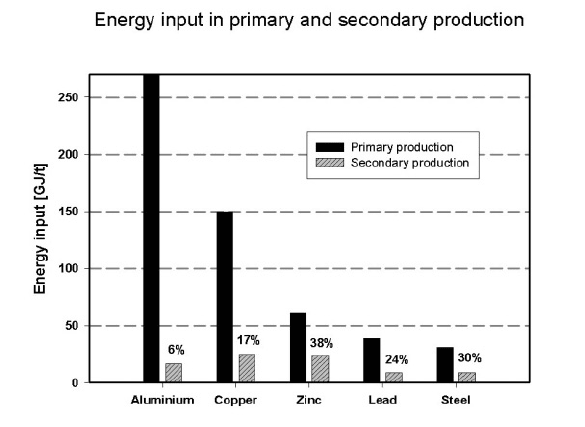
534 CHAPTER 6. INDUSTRIAL APPLICATIONS
Figure 6.55: Comparson of the energy input in primary and secondary metal
production (adapted from [N12]).
10 min) at a purity of the concentrate in excess of 90% [P23]. It was observed
that in order to achieve percentage capture similar to the normal red cells case,
the flow rate for parasitized cells had to be reduced by one order of magnitude.
6.6 Recovery of metals from wastes
Resource conservation by re-use, reclamation and recycling of materials has
been practiced for millennia, and the recovery of metals and alloys is a prime
example of such activities. The recovery of materials from waste and recycling of
materials are of increasing importance due to a wide spectrum of factors [V11].
Increased scarcity of economically viable deposits of ores, energy saving, and
increased emphasis on environmental control are some of the more important
ones. Significant reduction of energy input in metal recycling compared to
primary production is illustrated in Fig. 6.55, while Fig. 6.56 shows the relative
costs of mining and extraction of various metallic products.
It is argued [V11] that it is the economic cost, rather than actual physical
depletion, that will provide constraints on resource use in the future. It is likely
that the only structural metals which will not be in short supply in the future
are magnesium (from sea water), aluminium and iron [V11]. It is thus clear that
recycling of materials is strongly associated with the economics of producing raw
materials. This implies that for a financially self-sustaining system, the value of
the recycled materials must exceed the cost of producing them [N13]. Recycling
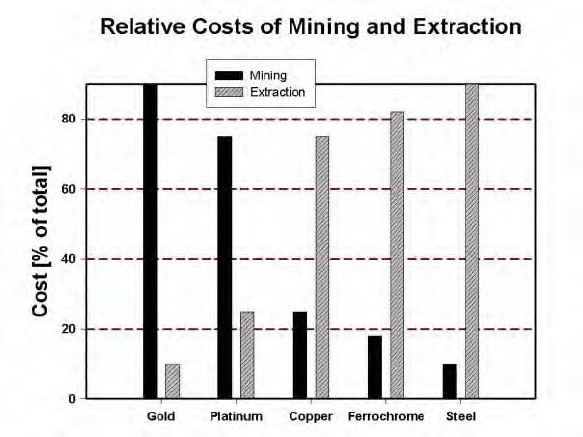
6.6. RECOVERY OF METALS FROM WASTES 535
Figure 6.56: Comparison of relative costs of mining and extraction of various
metallic products (adapted from [N12]).
will, therefore, take place only where the economic incentive is great enough.
6.6.1 The separation processes in metal recycling
In broad terms physical separation methods can be divided into dismantling,
liberation, dry and/or wet separation and melting [N13, D21]. After liberation,
a metal must be separated from a variety of materials. Materials have many
unique physical and chemical properties, which may be applied in separation
processes, ranging from colour and density to magnetic and electrical properties.
Various dry and wet separation methods are used in practice, and their size
ranges are listed in Tables 6.27 and 6.28.
Magnetic separation
Suspended magnets, magnetic pulleys and dry low-intensity drum magnetic sep-
arators are frequently used in metal recycling processes for concentration of fer-
romagnetic materials. These magnetic separators are usually situated directly
after the primary shredder, or just after the air classifier, if used. Occasionally,
secondary low-intensity magnetic separators are utilized to retrieve the 10% to
20% of ferrous metal missed by the primary separator. It is often necessary to
re-shred and then air-classify a magnetic concentrate to free contaminants such
as the contents of tin cans [V11]. A schematic diagram of major process steps

536 CHAPTER 6. INDUSTRIAL APPLICATIONS
Table 6.27: Dry separation techniques for recycling (after Dalmijn et al. [D21]).
Dry separation Particle size range [mm]
Gravity or density sorting
Screening and sizing 1 - 100
Centrifuges and cyclones 0.05 - 20
Air classification 5 - 100
Friction separators, shaking tables 0.05 - 5
Magnetic and electrostatic separation
Magnetic separation 0. 5 - 100
Eddy-current separation 1 - 100
Corona discharge separators 0.1 - 10
Triboelectrical separators 0.1 - 10
Particle-for-particle separation
Sensors for material recognition 1 - 100
Image processing 1 - 100
Multi-sensor systems 1 - 100
Table 6.28: Wet separation techniques for recycling (after Dalmijn et al. [D21]).
Wet separation Particle size range [mm]
Gravity or density separation
Classification 1 - 100
Rising current separators 1-50
Centrifuges 1-50
Cyclones 0.05 - 0.5
Sink-float or DMS 1 - 100
Jigging 1-50
Flotation 0.05 - 0.5
Electromagnetic separation
Magnetic separators 0.1 - 1
Eddy current or Magnus separators 0.05 - 5
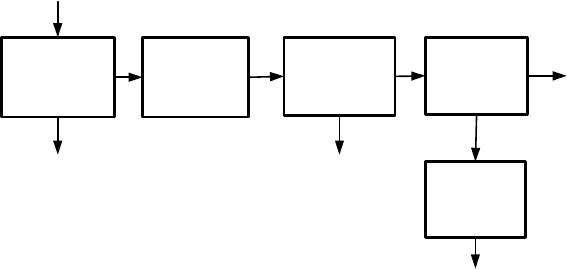
6.6. RECOVERY OF METALS FROM WASTES 537
Decontamina-
tion/Partial
dismantling
Size
reduction
Air
classification
Magnetic
separation
Non-ferrous
separation
Obsolete cars
Batteries, fuel, oil
ASR, 25%
65%
Heavy ASR, 5%
Pb, Cu, Zn,
brass,
ss steel
Figure 6.57: Major process operations in the mechanical processing of auto-
mobile scrap. ASR - autmotive shredder residue (adapted from
Dalmijn et al. [D21]).
is shown in Fig. 6.57.
Dry drum magnetic separators equipped with rare-earth magnets are used
for recovery of feebly magnetic stainless steel.
Wet low-intensity drum magnetic separators are used to recover magnetite
and ferrosilicon from dense media plants prior to feeding scrap material to an
eddy-current separation plant. High-intensity magnetic separators are also used
to remove iron-aluminium, a complex material consisting of aluminium and
magnetic parts mechanically connected, such as steel bolts [N13].
Eddy-current separation
Eddy-current separators are used in recycling in combination with a dense me-
dia separation plant to improve the grade and recovery of the metal products.
Magnesium and aluminium are the first products from a dense media plant fed
primarily with material from automobile shredders. This product still contains
materials that responded to the same cut-point density at which DMS operated.
These materials, such as stones, glass, copper wire and complex materials rep-
resent approximately 10% of the aluminium fraction with a size range of 10 to
65 mm [N13]. The aluminium concentrate can be obtained in a process shown
in Fig. 6.55. The feed to an eddy-current separator is usually screened into two
fractions, for instance - 32 + 8 mm and - 65 + 32 mm.
The heavy non-ferrous fraction obtained in DMS can also be processed by
eddy-current separators. The current technology cannot, however, separate the
heavy non-ferrous mixture into the final concentrates of individual components,
such as zinc, lead and copper [N13]. However, eddy-current separators are useful
to produce pre-concentrates for further sorting, for instance by image processing.
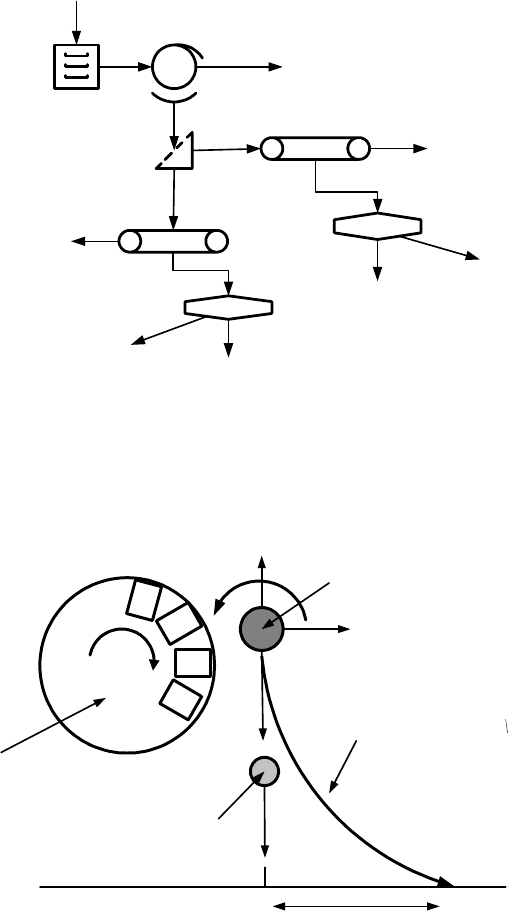
538 CHAPTER 6. INDUSTRIAL APPLICATIONS
Aluminium float, 16 - 65
mm
Dryer
LIMS
Ferrous
metal
Screen
ECS
Al product
Friction
separator
ECS
Cu wire
Reject
Cu wire
Reject
Al product
Figure 6.58: Schematic diagram of the processing of the aluminium float frac-
tion with eddy-current (ECS) and friction separators (adapted from
Nijkerk and Dalmijn [N13]).
S
N
S
N
Fg
Fd
FL
Rotating
magnet
Non-ferrous
metal particle
Deflection
Particle
trajectory
Non-metal
particle
Figure 6.59: Principle of separation of non-ferrous metal particles from non-
metal particles using the Magnus eect. FL = lift force.
6.6. RECOVERY OF METALS FROM WASTES 539
Separation by Magnus-Robins Eect
It was demonstrated by Robins and later by Magnus that a particle, rotating
either in water or air, does not fall strictly vertically, but, as a result of asymme-
try of the flow and pressures around the rotating particle, a lift force is created
that aects the particle trajectory [M45, B51, T13].
It has been suggested by Rem et al. [F36] that this eect can be applied to
the separation of fine non-ferrous metal particles from a mixture. By exposing
a mixture of vertically falling particles to a rotating magnetic field, the non-
ferrous metal particles, in contrast to non-metallic particles, also start rotating.
The Magnus lift force thus created deflects the metal particles from the vertical
direction, as shown in Fig. 6.59.
A wet Magnus separator was applied, on pilot scale, to the separation of
copper and aluminium particles from the bottom ash of a municipal waste in-
cinerator [F36]. A production-size plant with a throughput of 50 t/h has been
proposed [R31]. The wet Magnus separator can treat particles in the size range
from 0.5 to 20 mm, while in a dry mode the size range is from 0.2 to 5 mm.
6.6.2 Sorting of heavy non-ferrous metals
Heavy non-ferrous metals include copper, lead, zinc, titanium, cobalt and pre-
cious metals such as silver, gold and platinum, and metal alloys such as brass
(Cu+Zn) and bronze (Cu+Sn+Zn). Approximately 75% of the mixture of heavy
non-ferrous metals comes from automobile scrap, the source of the rest being
electronic and domestic waste. Brass and copper make up approximately 70%
of the value of the mixture, as is illustrated in Fig. 6.60.
Hand sorting is generally the most cost-eective method for sorting of heavy
metals. Labour rates for sorting in Asia are low and the costs of shipping scrap
materials, from most parts of the world, to Asia are presently very attractive.
Moreover, the Asian markets for non-ferrous metals are more attractive than,
for instance, the European markets.
A rather recent entry into the sorting of heavy non-ferrous metals is colour
sorting. High-speed, real-time processors interpret images from high-resolution
cameras. The processors are pre-programmed to recognize certain metals by
colour and geometry and compressed air is used to eject the recognized metal
fragments. One metal type can be recovered per cycle per unit. The e!ciency of
this technique is limited by, for instance, insu!cient liberation, contamination,
dirt and corrosion. Recovery ranges from 80% for lead to 93% for zinc, while
the purity of the concentrates is approximately 95% to 98%.
Sorting in a magnetic fluid
Separation in magnetic fluids, and particularly in ferrofluids (FHS) is a natural
choice for sorting of non-ferrous metals into individual metal concentrates. Con-
siderable eort was expended to develop the FHS for the treatment of automo-
bile scrap [K16, K17, F21, S50, N4, R9, H35, A44], followed by the application
